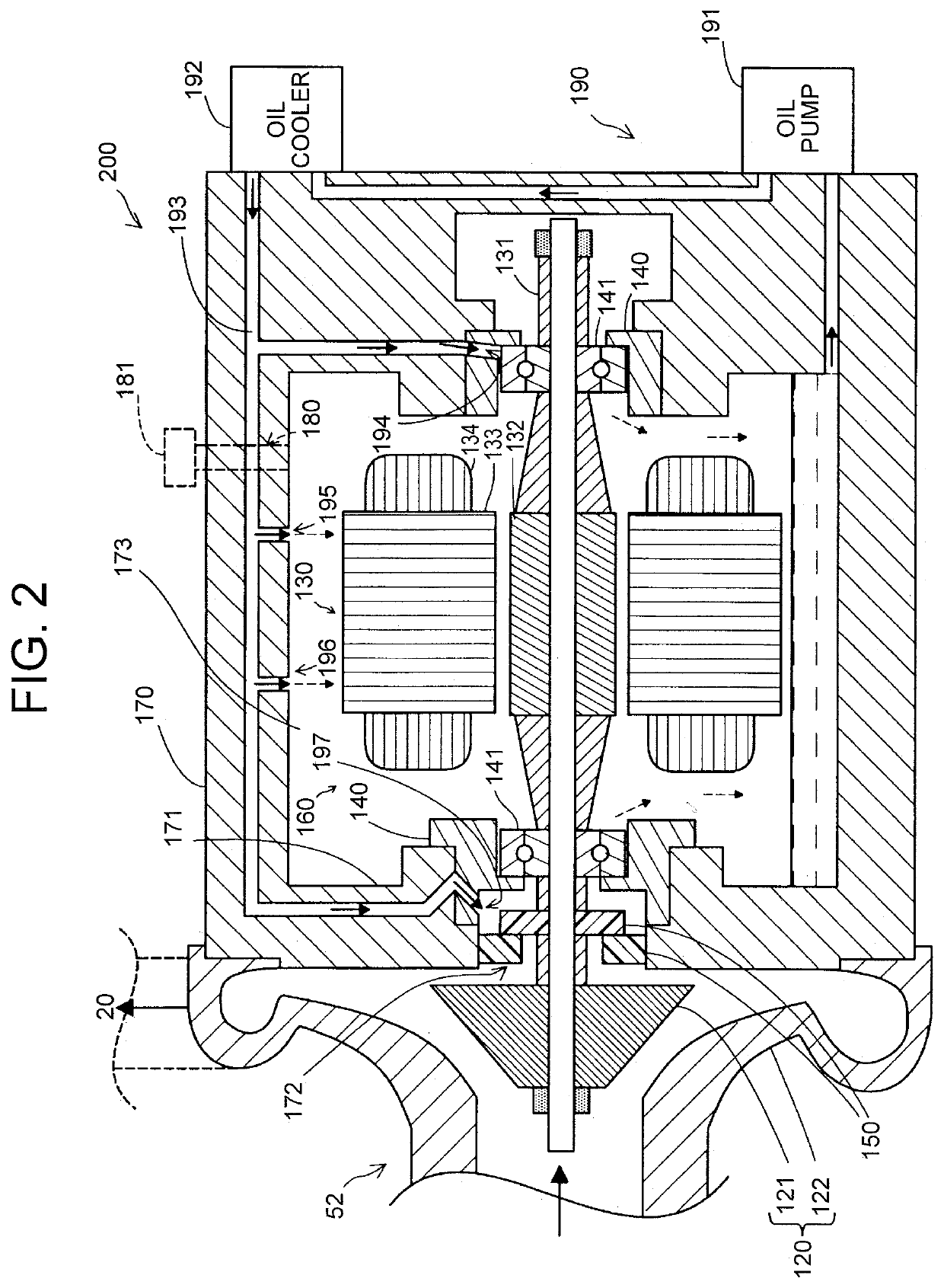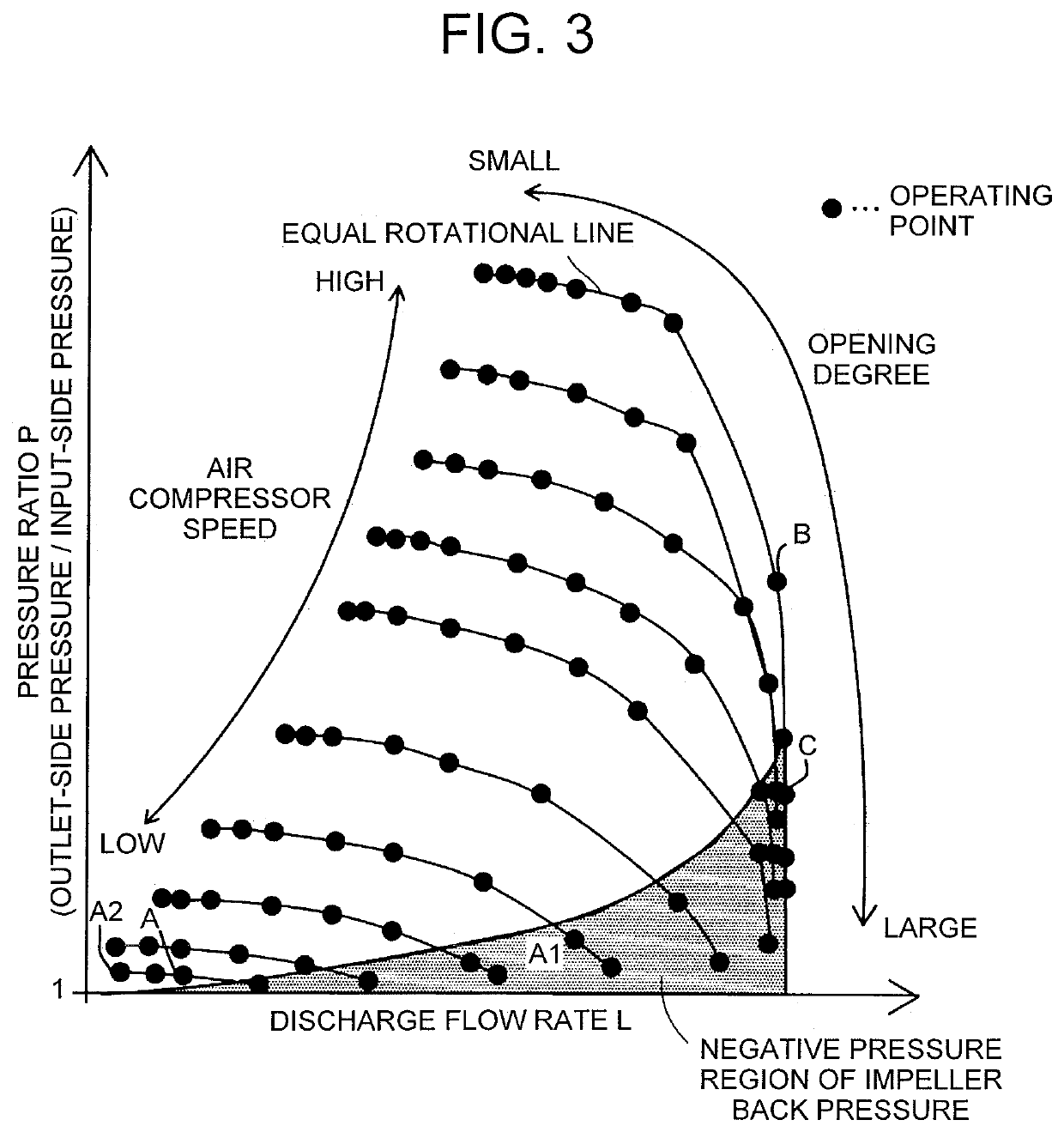Fuel cell system and control method of fuel cell system
a fuel cell and control method technology, applied in the direction of fuel cells, motive system fuel cells, electrical devices, etc., can solve the problems of oil in the housing leaking to the supply passage and flowing into the fuel cell
- Summary
- Abstract
- Description
- Claims
- Application Information
AI Technical Summary
Benefits of technology
Problems solved by technology
Method used
Image
Examples
first embodiment
A. First Embodiment
[0018]FIG. 1 is a schematic view of a fuel cell system 100 according to a first embodiment. In the present embodiment, the fuel cell system 100 generates electric power by a reaction of fuel gas (anode gas) and oxidant gas (cathode gas). For example, the fuel cell system 100 is mounted on a fuel cell vehicle, and is used as a power generator for driving a driving motor. The fuel cell system 100 includes a fuel cell stack 20, an oxidant gas supply and discharge mechanism 50, a fuel gas supply mechanism 60, a coolant circulation mechanism 70, and a controller 90. The coolant circulation mechanism 70, which is connected to the fuel cell stack 20, has a coolant circulation passage 71 that passes coolant (for example, water), and a pump (not shown) that pumps the coolant.
[0019]The fuel cell stack 20 has a stack structure formed by stacking a plurality of fuel cell unit cells (not shown). In the present embodiment, each of the fuel cell unit cells that constitute the fu...
second embodiment
B. Second Embodiment
[0050]FIG. 6 is a flowchart of an operating point changing process executed by the controller 90 of the fuel cell system 100 according to a second embodiment. FIG. 7 is a second drawing showing the relationship between the operating point and the negative pressure region. In FIG. 6, when the process similar to the process shown in FIG. 5 is executed, the process is designated by the similar reference sign.
[0051]The fuel cell system 100 according to the second embodiment is different from the fuel cell system 100 according to the first embodiment in the contents of the operating point changing process executed by the controller 90. In the first embodiment, when the first operation is executed, the first process (steps S111 to S113 of FIG. 5) is executed regardless of whether or not the impeller back face pressure may become negative. When the second operation is executed, the second process (steps S121 to S123 of FIG. 5) is executed regardless of whether or not th...
third embodiment
C-1. Third Embodiment
[0055]In the above embodiments, although the controller 90 executes both the first process and the second process, the present disclosure is not limited to this configuration. The controller 90 may execute only one of the first process and the second process. For example, the controller 90 may execute the first process when performing the first operation, and execute normal control when performing the second operation. This makes it possible to suppress the impeller back face pressure becoming negative when the first operation is performed. For example, the controller 90 may execute the second process, when performing the second operation, and execute normal control when performing the first operation. This makes it possible to suppress the impeller back face pressure becoming negative when the second operation is performed. In both the configurations, it is possible to suppress the impeller back pressure becoming negative in one of the cases where the first ope...
PUM
| Property | Measurement | Unit |
|---|---|---|
| area | aaaaa | aaaaa |
| speed | aaaaa | aaaaa |
| pressure | aaaaa | aaaaa |
Abstract
Description
Claims
Application Information
 Login to View More
Login to View More - R&D
- Intellectual Property
- Life Sciences
- Materials
- Tech Scout
- Unparalleled Data Quality
- Higher Quality Content
- 60% Fewer Hallucinations
Browse by: Latest US Patents, China's latest patents, Technical Efficacy Thesaurus, Application Domain, Technology Topic, Popular Technical Reports.
© 2025 PatSnap. All rights reserved.Legal|Privacy policy|Modern Slavery Act Transparency Statement|Sitemap|About US| Contact US: help@patsnap.com



